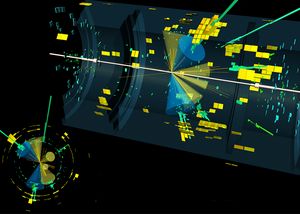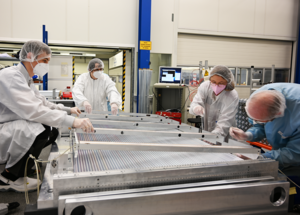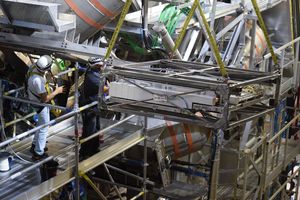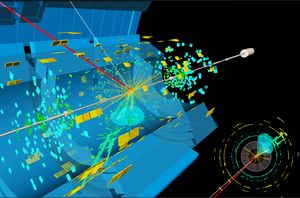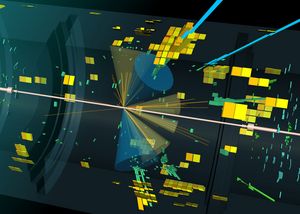Together with scientists from around the world, physicists at the MPP have developed and constructed the particle detector ATLAS. ATLAS is an experiment at the Large Hadron Collider (LHC), a particle accelerator at the CERN research center in Geneva. The LHC began operating in 2008. In March 2010, the research program got under way at this proton-proton accelerator, working with the highest energies achieved to date at any accelerator facility. With the help of the LHC, researchers from all over the world want to coax out the secrets of the structure of matter and the fundamental forces.
ATLAS records the results of proton-proton collisions produced by the LHC. In the process, conditions similar to those in the extremely early, hot and dense universe shortly after the Big Bang are created. From that, the researchers gain insights about the fundamental building blocks of matter as well as their interactions. They are looking for new phenomena, such as the existence of higher dimensions of space and time and the origin of the dark matter that holds our universe together.
The MPP was and is involved with the development of instruments essential to the ATLAS detector – the inner detector, the calorimeters, and the muon chambers – as well as the setup of the computing system. A major technical upgrade is scheduled to start from 2026. The goal is to increase the number of proton collisions in order to obtain more data. MPP scientists and technicians are working to make ATLAS fit for the coming surge of new data.
30 years of ATLAS
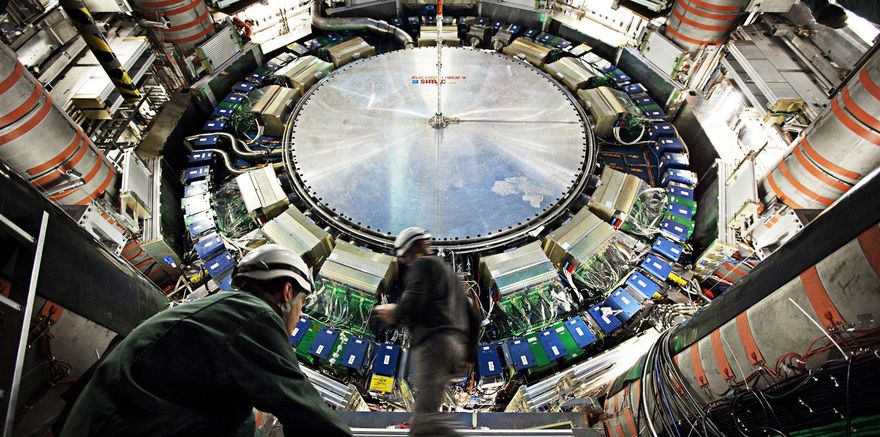
The history of the truly big experiment began on October 1, 1992, when close to 90 research instituitions signed a common letter of intent to build a detector for proton-proton collisions. The Max Planck Institute for Physics was one these, its scientists contributed to the devolopment of major ATLAS components.
The greatest success of the ATLAS experiment so far was the discovery of the Higgs boson in 2012. As early as the 1960s, the theoretical phycisitst Peter Higgs, François Englert and Robert Brouthad proposed the existence of this particle: As a building block of the Standard Model, it gives other elementary particles their mass. For this, Higgs and Englert received the 2013 Nobel Prize.
Since June 2015, the LHC accelerator has been running with a record energy of 13 teraelectronvolts – nearly twice as much as in the years before. With that, the researchers hope to discover "new physics" – that is, particles and effects that do not occur in the Standard Model but which could help to solve the puzzles of the dark matter, the dark energy, and the missing antimatter in the universe.
ATLAS at the MPP
News releases
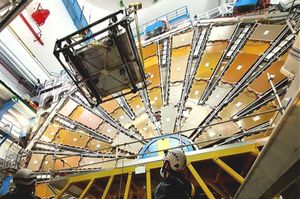
New muon detectors for the ATLAS experiment
MPP completes first detector project for the High Luminosity LHC

MPI for Physics launches international initiative for chip technology
First meeting of the FPGA Developers’ Forum from 11-13 June, 2024
News releases

New muon detectors for the ATLAS experiment
MPP completes first detector project for the High Luminosity LHC

MPI for Physics launches international initiative for chip technology
First meeting of the FPGA Developers’ Forum from 11-13 June, 2024
Group members
E-mail address: e-mail@mpp.mpg.de
Phone number: +49 89 32354-extension
name
function
e-mail
extension
office
Barillari, Teresa, Dr.
Senior Scientist
teresa.barillari
369
A.1.41
Bethke, Siegfried, Prof. Dr.
Emeritus
siegfried.bethke
381
A.2.05
Bharthuar, Shudhashil, Dr.
Postdoc
shudhashil.bharthuar
462
A.1.39
Britzger, Daniel, Dr.
Postdoc
daniel.britzger
453
A.2.28
Buchin, Daniel
PhD Student
daniel.buchin
376
A.2.21
Cieri, Davide, Dr.
Senior Scientist
davide.cieri
226
A.2.10
Costa, Davide
Student
davide.costa
503
A.2.15
Cuppini, Elena
PhD Student
elena.cuppini
376
A.2.21
D'Andrea, Michele
Student
michele.dandrea
511
A.3.03
Delle Fratte, Cesare
Senior Scientist
cesare.delle.fratte
518
A.1.77
Düerkop, Paul
Student
paul.dueerkop
462
A.1.39
Eder, Stefan
Student
stefan.eder
503
A.2.15
Fallavollita, Francesco, Ph.D.
Postdoc
francesco.fallavollita
256
A.3.01
Greco, Matteo, Dr.
Postdoc
matteo.greco
511
A.3.03
Grewe, Simon
PhD Student
simon.grewe
358
A.2.19
Griese, Maximilian
Student
maximilian.griese
503
A.2.15
Hamilton, Arthur
Student
arthur.hamilton
299
A.3.03
Hessler, Johannes
PhD Student
johannes.hessler
453
A.2.28
Jia, Xuewei, Dr.
Postdoc
xuewei.jia
552
A.2.17
Kado, Marumi, Prof. Dr.
Director
marumi.kado
382
A.2.45
Kiryunin, Andrey, Ph.D.
Senior Scientist
andrey.kiryunin
286
A.0.91
Kluth, Stefan, PD Dr.
Senior Scientist
stefan.kluth
468
A.2.05
Kortner, Oliver, PD Dr.
Senior Scientist
oliver.kortner
240
A.2.12
Kortner, Sandra, Dr.
Senior Scientist
sandra.kortner
288
A.2.14
Kroha, Hubert, Prof. Dr.
Senior Scientist
hubert.kroha
435
A.2.29
Kube, Nick
Student
nick.kube
503
A.2.15
Lautier, Remi
Student
remi.lautier
559
A.3.01
Leis, Ulrich
Engineering
ulrich.leis
550
A.1.67
Li, Changqiao, Ph.D.
Postdoc
changqiao.li
265
A.2.30
Lohrmann, Max Emanuel
Student
max.lohrmann
559
A.2.23
Maly, Pavel, Ph.D.
Engineering
pavel.maly
385
B.2.FL2
Meier, Nick
Student
nick.meier
503
A.2.15
Menke, Sven, Dr.
Senior Scientist
sven.menke
410
A.1.37
Murnauer, Josef
Student
josef.murnauer
453
A.2.28
Nisius, Richard, PD Dr.
Senior Scientist
richard.nisius
474
A.1.43
Okfen, Julia
Student
julia.okfen
503
A.2.15
Park, Tae Hyoun, Ph.D.
Postdoc
tae.hyoun.park
559
A.2.23
Proto, Giorgia, Dr.
Postdoc
giorgia.proto
559
A.3.01
Rafanoharana, Dimbiniaina Soanasolo
PhD Student
dimbiniaina.soanasolo
265
A.2.30
Resende, Francisco
Student
francisco.resende
559
A.2.23
Richter, Robert, Dr.
Senior Scientist
robert.richter
258
A.1.15
Rückwarth, Dario
Student
dario.ruckwarth
559
A.2.23
Saborido Patino, Alberto
Student
alberto.saborido
453
A.2.28
Schacht, Peter, Dr.
Emeritus
peter.schacht
228
A.1.15
Schielke, Anja
Secretary
anja.schielke
299
A.2.47
Schmidt, Elia
PhD Student
elia.schmidt
552
A.2.17
Schäfer, Tim
Student
tim.schafer
376
A.2.21
Soyk, Daniel
Engineering
daniel.soyk
374
B.2.FL2
Spitzauer, Luca Matthias
PhD Student
luca.spitzauer
220
A.2.19
Stonjek, Stefan, Dr.
Senior Scientist
stefan.stonjek
296
A.2.26
Tabriz, Meisam, Dr.
IT
meisam.tabriz
603
A.1.77
Verbytskyi, Andrii, Dr.
Senior Scientist
andrii.verbytskyi
454
A.2.31
Voevodina, Elena, Dr.
Postdoc
elena.voevodina
559
A.2.23
Weber, David
Student
david.weber
299
A.2.15
Wenke, Nina
PhD Student
nina.wenke
767
A.2.19
Wesely, Bastian
Student
bastian.wesely
503
A.2.15
Zhou, Fan
Student
fan.zhou
503
A.2.15
Zimmermann, Jörg
Engineering
joerg.zimmermann
446
B.2.35
Group members
Phone number: +49 89 32354-extension
| name | function | extension | office | |
|---|---|---|---|---|
| Barillari, Teresa, Dr. | Senior Scientist | teresa.barillari | 369 | A.1.41 |
| Bethke, Siegfried, Prof. Dr. | Emeritus | siegfried.bethke | 381 | A.2.05 |
| Bharthuar, Shudhashil, Dr. | Postdoc | shudhashil.bharthuar | 462 | A.1.39 |
| Britzger, Daniel, Dr. | Postdoc | daniel.britzger | 453 | A.2.28 |
| Buchin, Daniel | PhD Student | daniel.buchin | 376 | A.2.21 |
| Cieri, Davide, Dr. | Senior Scientist | davide.cieri | 226 | A.2.10 |
| Costa, Davide | Student | davide.costa | 503 | A.2.15 |
| Cuppini, Elena | PhD Student | elena.cuppini | 376 | A.2.21 |
| D'Andrea, Michele | Student | michele.dandrea | 511 | A.3.03 |
| Delle Fratte, Cesare | Senior Scientist | cesare.delle.fratte | 518 | A.1.77 |
| Düerkop, Paul | Student | paul.dueerkop | 462 | A.1.39 |
| Eder, Stefan | Student | stefan.eder | 503 | A.2.15 |
| Fallavollita, Francesco, Ph.D. | Postdoc | francesco.fallavollita | 256 | A.3.01 |
| Greco, Matteo, Dr. | Postdoc | matteo.greco | 511 | A.3.03 |
| Grewe, Simon | PhD Student | simon.grewe | 358 | A.2.19 |
| Griese, Maximilian | Student | maximilian.griese | 503 | A.2.15 |
| Hamilton, Arthur | Student | arthur.hamilton | 299 | A.3.03 |
| Hessler, Johannes | PhD Student | johannes.hessler | 453 | A.2.28 |
| Jia, Xuewei, Dr. | Postdoc | xuewei.jia | 552 | A.2.17 |
| Kado, Marumi, Prof. Dr. | Director | marumi.kado | 382 | A.2.45 |
| Kiryunin, Andrey, Ph.D. | Senior Scientist | andrey.kiryunin | 286 | A.0.91 |
| Kluth, Stefan, PD Dr. | Senior Scientist | stefan.kluth | 468 | A.2.05 |
| Kortner, Oliver, PD Dr. | Senior Scientist | oliver.kortner | 240 | A.2.12 |
| Kortner, Sandra, Dr. | Senior Scientist | sandra.kortner | 288 | A.2.14 |
| Kroha, Hubert, Prof. Dr. | Senior Scientist | hubert.kroha | 435 | A.2.29 |
| Kube, Nick | Student | nick.kube | 503 | A.2.15 |
| Lautier, Remi | Student | remi.lautier | 559 | A.3.01 |
| Leis, Ulrich | Engineering | ulrich.leis | 550 | A.1.67 |
| Li, Changqiao, Ph.D. | Postdoc | changqiao.li | 265 | A.2.30 |
| Lohrmann, Max Emanuel | Student | max.lohrmann | 559 | A.2.23 |
| Maly, Pavel, Ph.D. | Engineering | pavel.maly | 385 | B.2.FL2 |
| Meier, Nick | Student | nick.meier | 503 | A.2.15 |
| Menke, Sven, Dr. | Senior Scientist | sven.menke | 410 | A.1.37 |
| Murnauer, Josef | Student | josef.murnauer | 453 | A.2.28 |
| Nisius, Richard, PD Dr. | Senior Scientist | richard.nisius | 474 | A.1.43 |
| Okfen, Julia | Student | julia.okfen | 503 | A.2.15 |
| Park, Tae Hyoun, Ph.D. | Postdoc | tae.hyoun.park | 559 | A.2.23 |
| Proto, Giorgia, Dr. | Postdoc | giorgia.proto | 559 | A.3.01 |
| Rafanoharana, Dimbiniaina Soanasolo | PhD Student | dimbiniaina.soanasolo | 265 | A.2.30 |
| Resende, Francisco | Student | francisco.resende | 559 | A.2.23 |
| Richter, Robert, Dr. | Senior Scientist | robert.richter | 258 | A.1.15 |
| Rückwarth, Dario | Student | dario.ruckwarth | 559 | A.2.23 |
| Saborido Patino, Alberto | Student | alberto.saborido | 453 | A.2.28 |
| Schacht, Peter, Dr. | Emeritus | peter.schacht | 228 | A.1.15 |
| Schielke, Anja | Secretary | anja.schielke | 299 | A.2.47 |
| Schmidt, Elia | PhD Student | elia.schmidt | 552 | A.2.17 |
| Schäfer, Tim | Student | tim.schafer | 376 | A.2.21 |
| Soyk, Daniel | Engineering | daniel.soyk | 374 | B.2.FL2 |
| Spitzauer, Luca Matthias | PhD Student | luca.spitzauer | 220 | A.2.19 |
| Stonjek, Stefan, Dr. | Senior Scientist | stefan.stonjek | 296 | A.2.26 |
| Tabriz, Meisam, Dr. | IT | meisam.tabriz | 603 | A.1.77 |
| Verbytskyi, Andrii, Dr. | Senior Scientist | andrii.verbytskyi | 454 | A.2.31 |
| Voevodina, Elena, Dr. | Postdoc | elena.voevodina | 559 | A.2.23 |
| Weber, David | Student | david.weber | 299 | A.2.15 |
| Wenke, Nina | PhD Student | nina.wenke | 767 | A.2.19 |
| Wesely, Bastian | Student | bastian.wesely | 503 | A.2.15 |
| Zhou, Fan | Student | fan.zhou | 503 | A.2.15 |
| Zimmermann, Jörg | Engineering | joerg.zimmermann | 446 | B.2.35 |
Key publications
Observation of a new particle in the search for the Standard Model Higgs boson with the ATLAS detector at the LHC
ATLAS Collaboration (Georges Aad (Freiburg U.) et al.). Jul 2012. 29 pp.
Published in Phys.Lett. B716 (2012) 1-29
arXiv:1207.7214
DOI: 10.1016/j.physletb.2012.08.020
The ATLAS Experiment at the CERN Large Hadron Collider
ATLAS Collaboration (G. Aad (Marseille, CPPM) et al.). 2008. 437 pp.
JINST 3 (2008) S08003
DOI: 10.1088/1748-0221/3/08/S08003
Measurements of the Higgs boson production and decay rates and coupling
strengths using pp collision data at √s=7 and 8 TeV in the ATLAS experiment
ATLAS Collaboration (Georges Aad (Marseille, CPPM) et al.). Jul 16, 2015. 64 pp.
Eur.Phys.J. C76 (2016) no.1
arXiv:1507.04548 [hep-ex]
DOI: 10.1140/epjc/s10052-015-3769-y
Measurement of the top quark mass in the tt¯→ lepton+jets
and tt¯→ dilepton channels using √s=7 TeV ATLAS data
ATLAS Collaboration (Georges Aad (Marseille, CPPM) et al.). Mar 18, 2015. 35 pp.
Published in Eur.Phys.J. C75 (2015) no.7, 330
arXiv:1503.05427
DOI: 10.1140/epjc/s10052-015-3544-0
Search for the electroweak production of supersymmetric particles in √s=8 TeV pp
collisions with the ATLAS detector
ATLAS Collaboration (Georges Aad (Marseille, CPPM) et al.). Sep 23, 2015. 61 pp.
Published in Phys.Rev. D93 (2016) no.5, 052002
arXiv:1509.07152 [hep-ex]
DOI: 10.1103/PhysRevD.93.052002
Key publications
Observation of a new particle in the search for the Standard Model Higgs boson with the ATLAS detector at the LHC
ATLAS Collaboration (Georges Aad (Freiburg U.) et al.). Jul 2012. 29 pp.
Published in Phys.Lett. B716 (2012) 1-29
arXiv:1207.7214
DOI: 10.1016/j.physletb.2012.08.020
The ATLAS Experiment at the CERN Large Hadron Collider
ATLAS Collaboration (G. Aad (Marseille, CPPM) et al.). 2008. 437 pp.
JINST 3 (2008) S08003
DOI: 10.1088/1748-0221/3/08/S08003
Measurements of the Higgs boson production and decay rates and coupling
strengths using pp collision data at √s=7 and 8 TeV in the ATLAS experiment
ATLAS Collaboration (Georges Aad (Marseille, CPPM) et al.). Jul 16, 2015. 64 pp.
Eur.Phys.J. C76 (2016) no.1
arXiv:1507.04548 [hep-ex]
DOI: 10.1140/epjc/s10052-015-3769-y
Measurement of the top quark mass in the tt¯→ lepton+jets
and tt¯→ dilepton channels using √s=7 TeV ATLAS data
ATLAS Collaboration (Georges Aad (Marseille, CPPM) et al.). Mar 18, 2015. 35 pp.
Published in Eur.Phys.J. C75 (2015) no.7, 330
arXiv:1503.05427
DOI: 10.1140/epjc/s10052-015-3544-0
Search for the electroweak production of supersymmetric particles in √s=8 TeV pp
collisions with the ATLAS detector
ATLAS Collaboration (Georges Aad (Marseille, CPPM) et al.). Sep 23, 2015. 61 pp.
Published in Phys.Rev. D93 (2016) no.5, 052002
arXiv:1509.07152 [hep-ex]
DOI: 10.1103/PhysRevD.93.052002
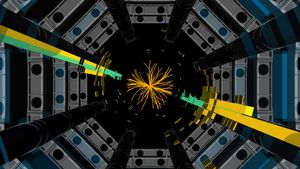
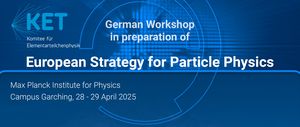
![[Translate to English:] ATLAS-Detektor The large-scale "ATLAS detector" project was initiated 30 years ago. (Photo: Claudia Marcelloni/CERN)](/fileadmin/_processed_/c/d/csm_ATLAS-30_2_2c393f5c92.jpg)
